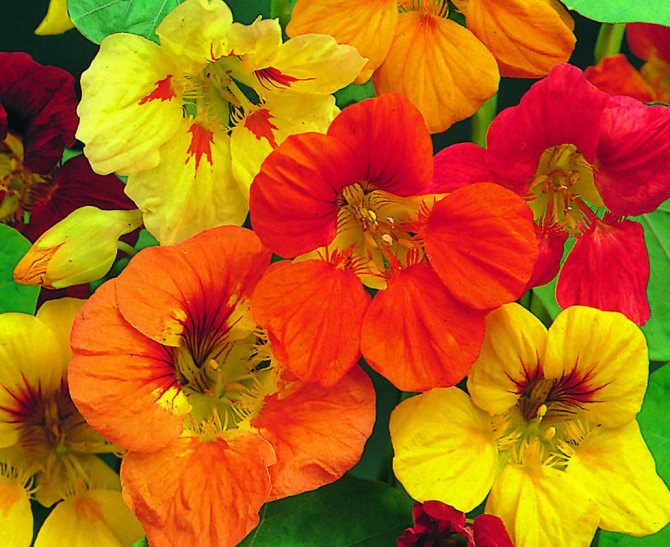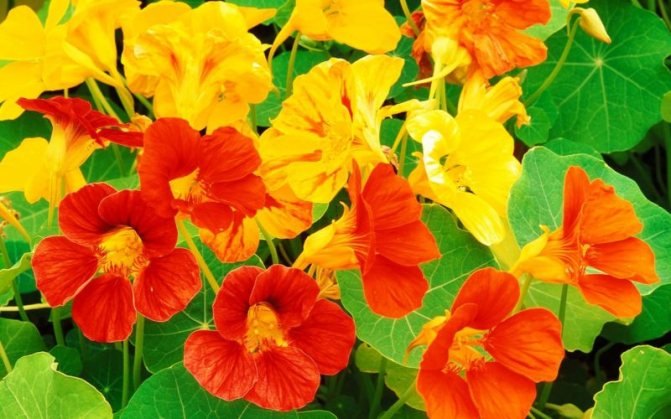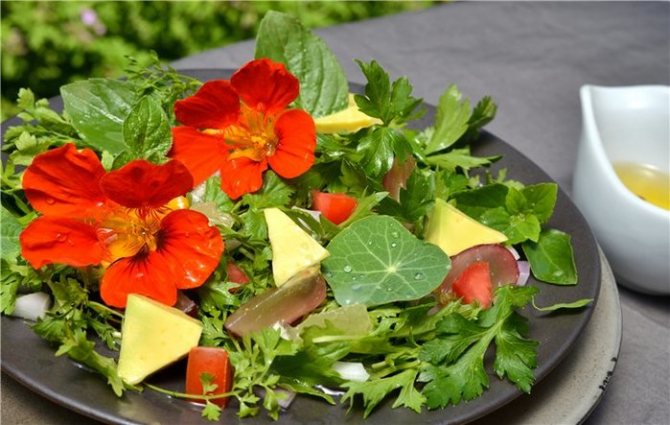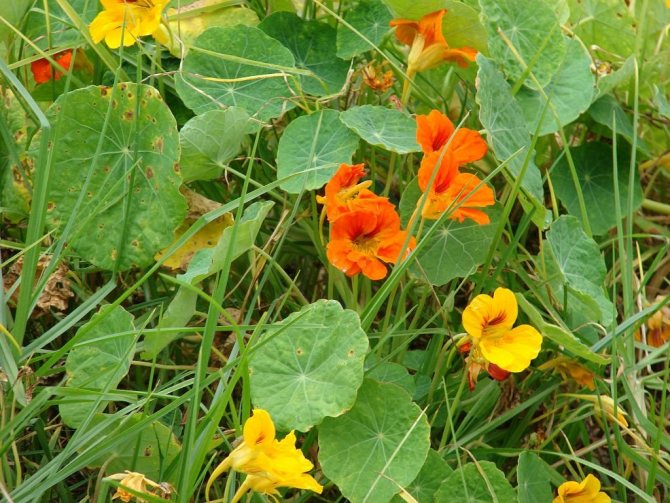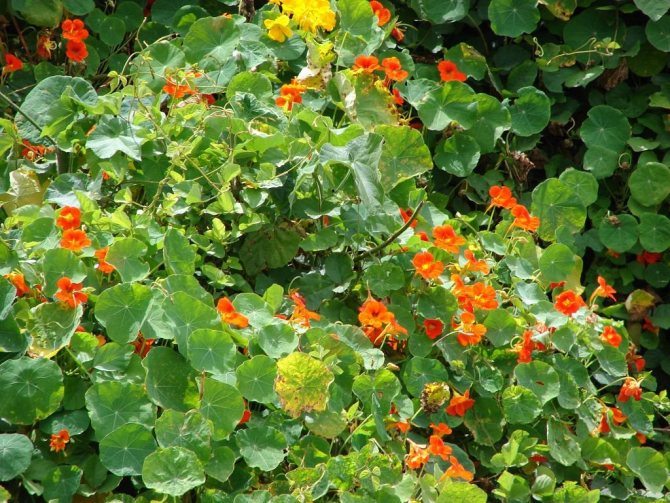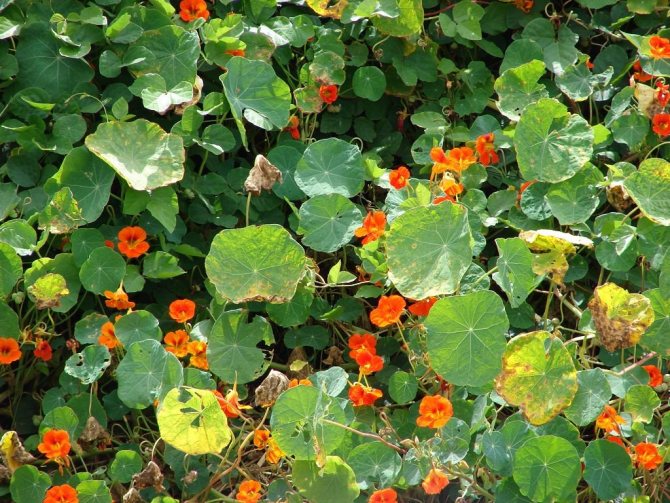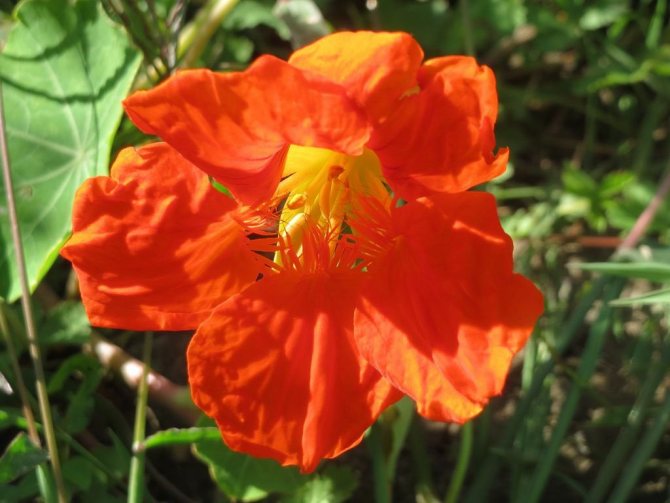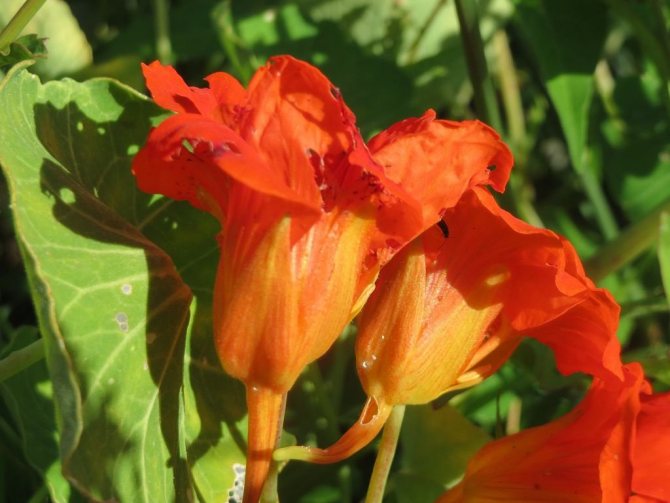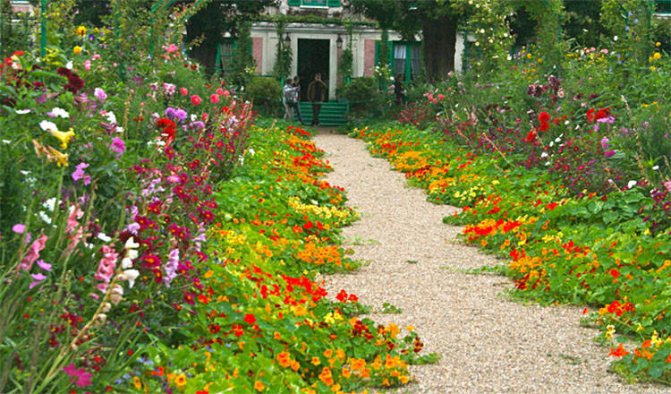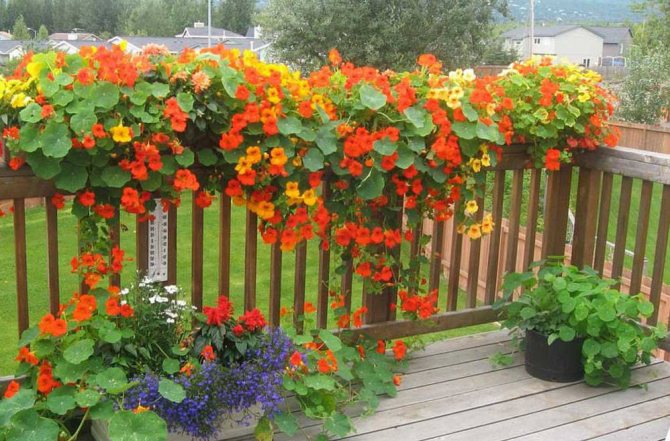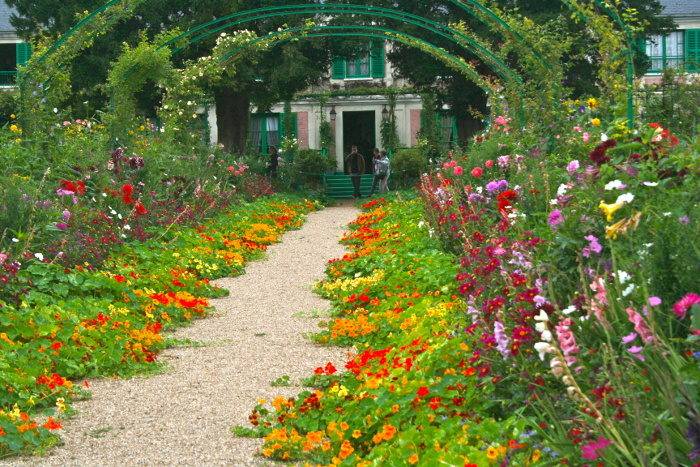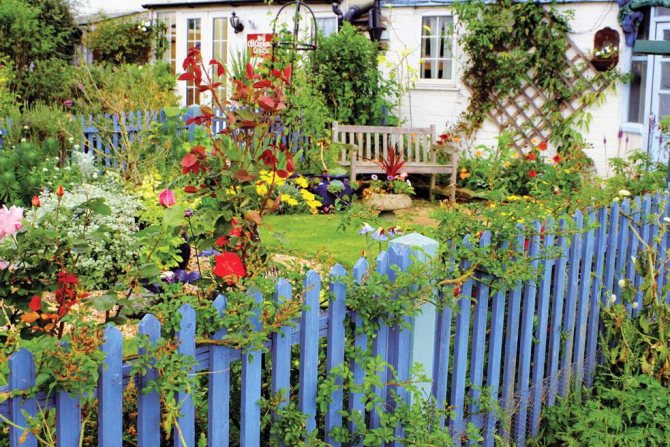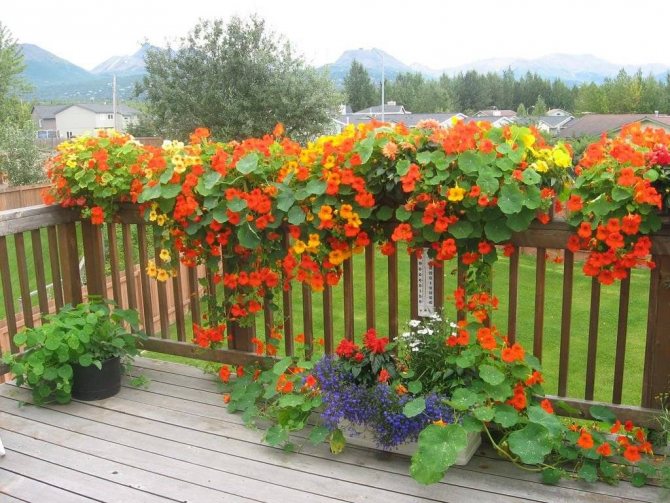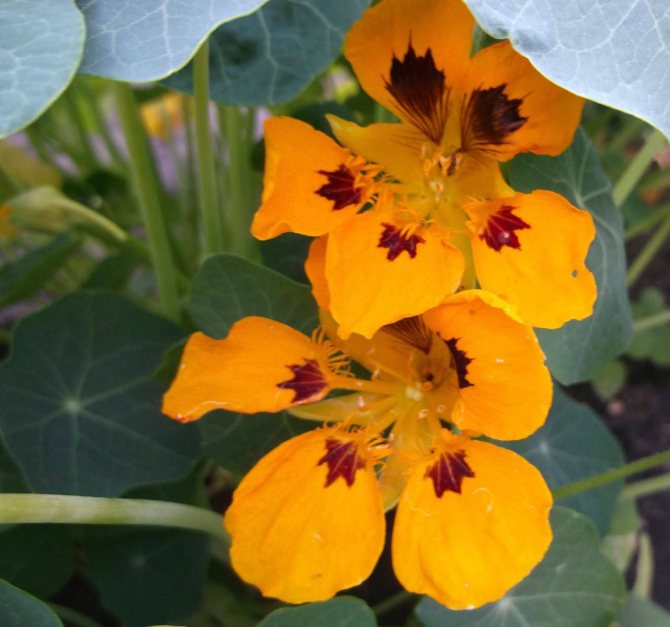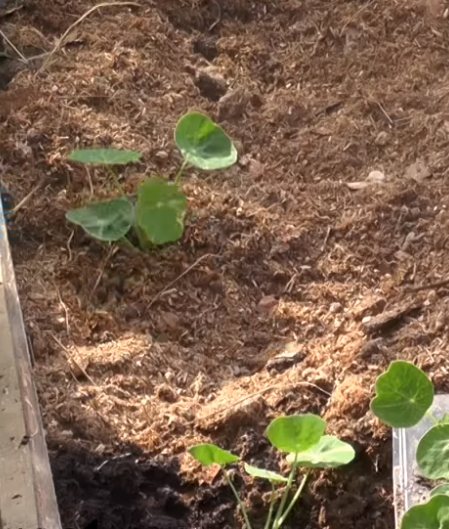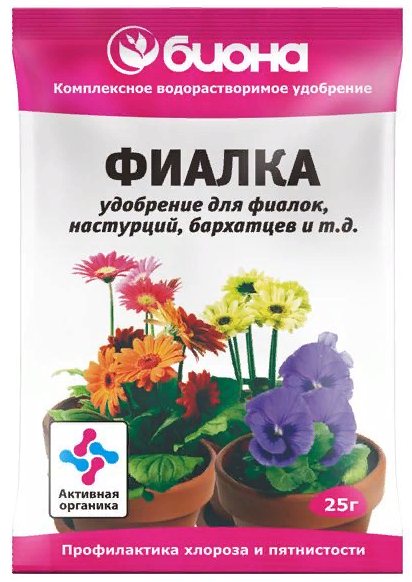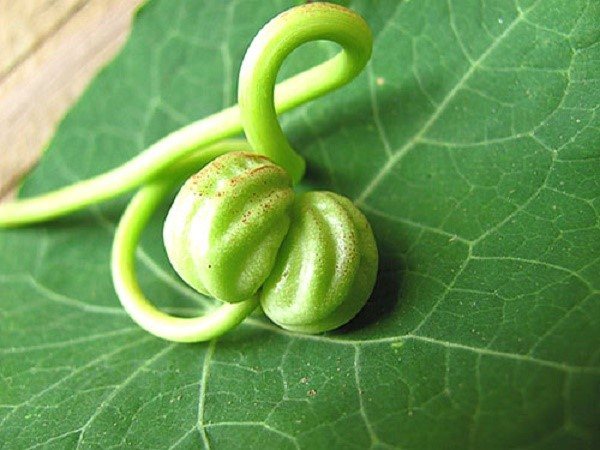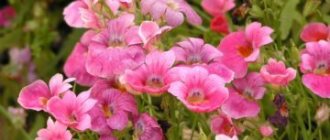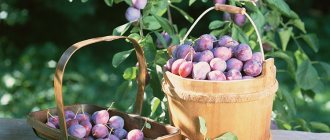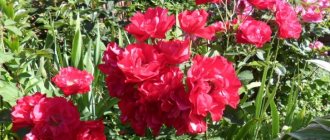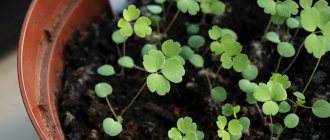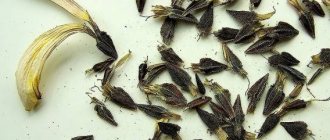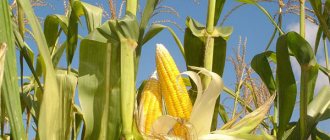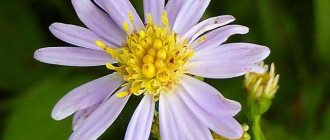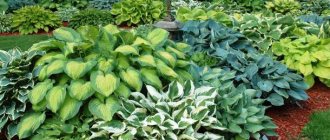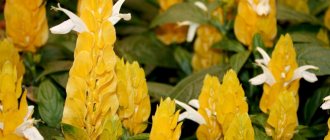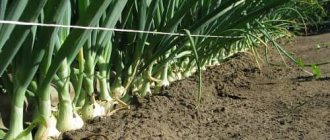Nasturtium is a herbaceous plant of the Nasturtiaceae family. There are approximately 90 types of these flowers. The plant originates from the South and Center of America. In our area, the plant has mastered for a long time thanks to Dutch flower growers.
Perennial, annual capuchins are nothing more than vines with juicy stems. Most often, the plant has lobed leaves. The flowers are velvet-like irregular in shape. Consist of five or more petals.
The colors of the flowers are different, but the most common are red, yellow varieties. Flowers and stems of nasturtium have medicinal properties, and are also widely used by chefs in the kitchen.
For the similarity of flowers to the monks' hooded clothes, the plant is called a capuchin. Usually nasturtium is grown on the balconies of houses, in the open field.
Description
Nasturtium varieties are:
- annuals;
- perennial.
As a rule, a long vine with bright leaves and flowers grows. Also come in the form of a bush.
Flowers exude a clear aroma and by the type of buds are found:
- semi-double;
- terry.
The bud has 5 petals that start from the cavity. Nectar gathers inside the flowers. Most often, flowers are colored yellow, red and orange.
In cooking, flowers are added to soups, salads and decorate various dishes with them.
- Dry, crushed is used instead of ground black pepper.
- Pickled fruits are similar to capers.
- Vinegar and oil are made from nasturtium.
Nasturtium in landscape design
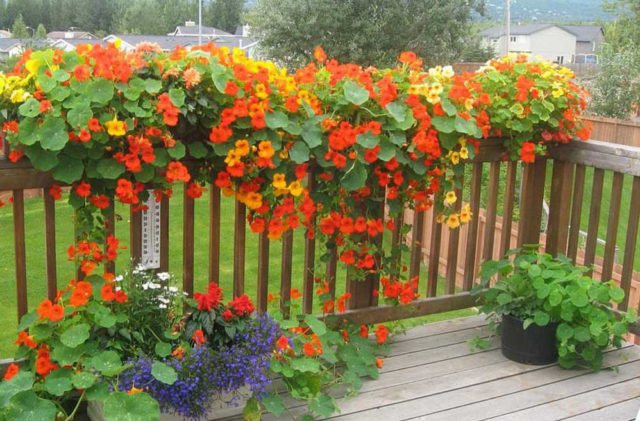
Lianas show themselves well in vertical gardening on trellises or horizontally on the ground. As the plant develops, it turns into a solid green carpet with bright flowers. They look spectacular on flower beds next to delphiniums, bells, ageratum.
Curly nasturtium is an adorable, unpretentious flower. With proper care, the plant will look much more luxuriant and more beautiful than the forgotten wild capuchins. In addition, nasturtium can be consumed as food and even as a medicine.
Types and varieties with photos
Wild nasturtium is a perennial plant. However, in central Russia, this flower is cultivated only as an annual, since it cannot survive the winter outdoors. Most of all gardeners grow cultivated species of nasturtium.
Foreign or Canary
Vines are native to South America. Shoots grow up to 3.5 m in length, quickly entwine vertical surfaces. It blooms from mid-summer to the very frost. Small yellow flowers with ruffled petals and green spurs. The leaves are also small, five- or seven-partite. Seeds do not have time to ripen in middle latitudes.
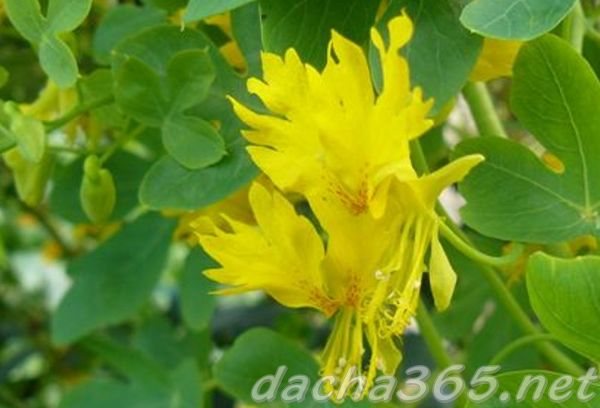

Big
The shoots are highly branched, fragile, growing up to 2.5 m in length. There are erect varieties that grow up to 70 cm in height.


It blooms from June until frost. It reproduces well by self-seeding. Seeds remain viable for 4 years. The leaves are large, asymmetrical, reaching 80 mm in diameter. On the one hand, they are green, on the other, they are gray. This species includes many varieties:
- King Theodore - bright red flowers.
- Peach Melba - cream flowers with a red spot in the center.
- Salmon Baby - semi-double flowers of a pale orange hue.
- ladybug - orange flowers with burgundy specks.


Cultural
It connects hybrids of large and shield-bearing nasturtium. Densely leafy shoots. The leaves are purple or green. The varieties differ in shape and height:
- compact - up to 50 cm;
- creeping - up to 4 meters;
- dwarf - up to 15–20 cm.
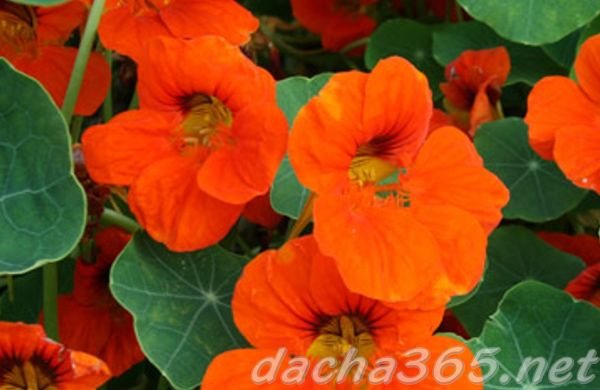

Varieties:
- Gleming Mahagani - bush up to 40 cm high with double red flowers.
- Golden Globe - a spherical bush up to 25 cm high and 40 cm wide. The leaves are round greenish. Double flowers are large, yellow-golden.
- Moonlight - shoots grow up to 2 m in length. Flowers are yellowish.
Small
Thin branchy shoots grow up to 35 cm Leaves are small, rounded, petioles are thin and long. The flowers are small, yellow, with dark spots in diameter reaching 3 cm. The upper petals are velvety with a sharp edge at the edges. The spurs are curved in a cylindrical shape. Blooms from June to October. Varieties:
- Cherry rose - 30 cm in height, red double flowers.
- Black Velvet - 30 cm in height, simple burgundy flowers. It reaches 6 cm in diameter. It is also called the "Black Lady".
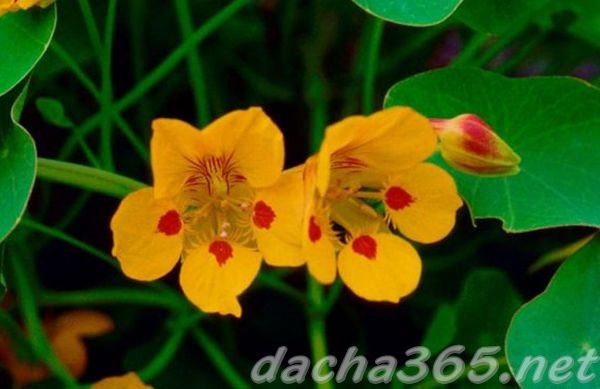

Shield-bearing
This is a creeping dwarf shrub with fragile 4-meter stems of a dark green color. Thyroid leaves are the same in color as the stems. The flowers are dark red. Blooms from June until frost. The seeds have time to ripen. The most popular variety of this species is Lucifer - an erect bush of high-rise buildings of 25 cm with green stems and large green leaves with a dark red tint. Flowers are simple orange-red in diameter up to 6 cm.
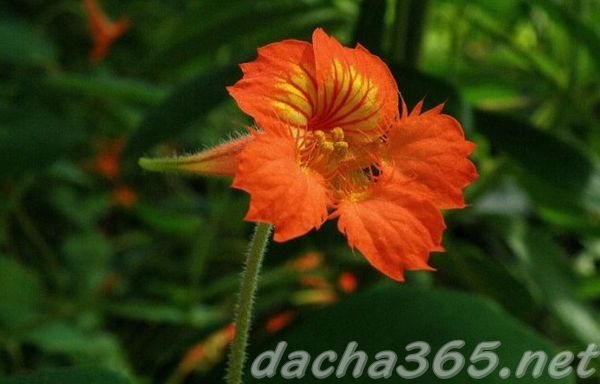

The decorative types of nasturtium also include azure, ciliated, multi-leaved, beautiful, tricolor. But they are rarely grown in Russia.
The specifics of care during the growing of seedlings
The appearance of sprouts indicates correct planting of nasturtium seed material.
The next step in obtaining full-fledged seedlings for further cultivation is caring for them. Despite the fact that the plant has long arrived from its homeland and settled down in the middle lane.


Temperature, lighting and humidity
An important part of caring for nasturtium seedlings is maintaining the temperature and microclimate in the room. The air warms up and is maintained at a level of 20-22 degrees throughout the entire time until the sprouts are 14-15 days old. It takes about a month to germinate.
After the specified period, the temperature is lowered to 18-20 degrees. In this case, the lighting should be abundant. Otherwise, the sprouts stretch out, change the shape of the leaves.
Therefore, the second rule is required: in low natural light, additional lighting is needed. In total, lighting is maintained for 15-16 hours of nasturtium.
The air in the room should be dry, but not overdried.
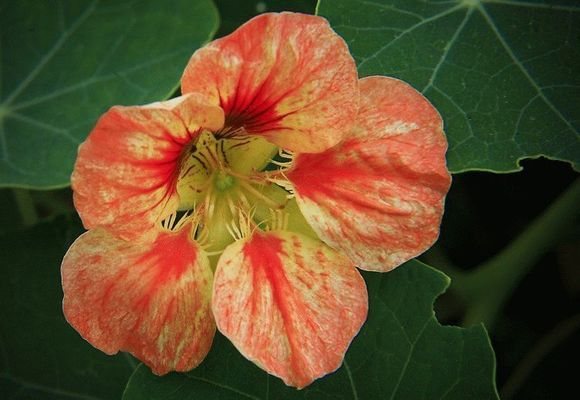

Watering and fertilizing
Watering the sprouts is often unnecessary. The plant prefers dryness. Spraying is not carried out. It is advisable to carry out watering by drip. Some growers make a special device (they introduce small hoses into separate holes in the glasses for gradual irrigation).
When to plant nasturtium seedlings
The flower is propagated in three ways:
- Seeds.
- Cuttings.
- Seedlings.


Interesting! The easiest way is to sow seeds in open ground. But first, it is recommended to sow seeds at home for seedlings, and then plant the seedlings in the garden when they get stronger.
The seedling method speeds up flowering. At home, seeds are sown:
- in the middle lane and the Moscow region from March 20 to April 10;
- in the northern regions, this procedure is carried out from April 15 to May 10.
Terry and new varieties are bred with cuttings, which must first be rooted in water or wet sand. This method allows you to preserve the varietal qualities of flowers.
Caring for room nasturtium


Indoor nasturtium pleases with abundant flowering much longer than garden nasturtium. At home, it can be grown as a perennial. But for a healthy development, she needs to provide decent living conditions.
Content
So that the plant does not experience discomfort, you need to provide:
- air temperature + 20 ... + 25o C (for the winter they are transferred to a cool room with a temperature of + 13 ... + 15o C);
- abundant lighting - it is best to place it on a windowsill on the south or west side;
- normal air humidity (if the room becomes too dry, the plant can be sprayed with a spray bottle).
Towards spring, the stems stretch out and turn pale. Before returning the pot to a sunny windowsill, the stems must be thoroughly trimmed.
Care
Caring for room nasturtium at home is almost the same as caring for a flower in the ground. The plant requires:
- Watering. Abundant moisture in the process of active growth of shoots and development of buds, in winter water is needed much less often. Watered with settled tap water, to soften, you can add 1 tsp. soda for 2 liters of liquid.
- Top dressing. Every 2 weeks, they are fed with a composition for flowering plants.
- Pruning. As the flowers dry, they are removed; it is also necessary to cut off the shoots so that the nasturtium does not bush too much.
Growing seedlings
For seedlings, it is better to use:
- biocontainers (compressed vermicompost in granules);
- peat pots or tablets;
- cups with a removable bottom (10 cm in diameter).
Advice! Nasturtium has weak roots, so it is not recommended to dive.
When growing seedlings in peat tablets, they are transplanted into a pot when 2 main leaves appear. The tablets will dissolve in the soil and additionally fertilize the soil.
The grown seedlings are transplanted together with an earthen clod, peat pots or biocontainers. Before this, the plants are hardened - they are taken out for 2-4 hours a day outside in warm weather. Nasturtium will bloom in 30-45 days.
Seed and soil preparation
Seeds are prepared before sowing:
- Sorting, removing underdeveloped, small and damaged.
- Then they are disinfected by placing for 15 minutes in a solution of potassium permanganate, heated to 60 degrees.
- Next, the seeds are wrapped in cheesecloth and kept in cool water for 24 hours.
- They can also be germinated a little and then planted in pots.
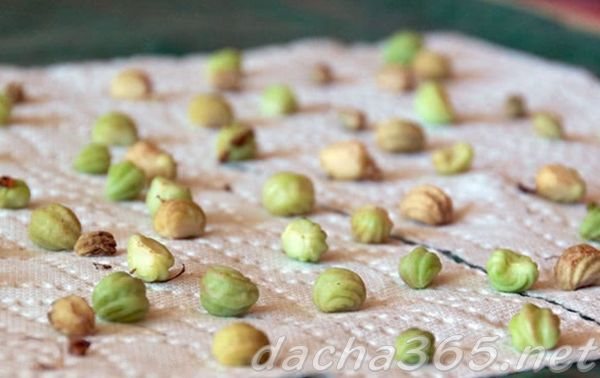

The soil can be bought at a garden store or made by yourself, combining in equal proportions:
- sod land;
- sand;
- peat.
All components are mixed well and sieved. Next, the soil is watered with a hot solution of potassium permanganate for disinfection and left at room temperature for 1-2 days.
The soil is poured into prepared containers and the seeds are sown.
Advice! Instead of a solution of potassium permanganate, you can use Fitosporin solution.
Sowing
Important! If the nasturtium grows indoors, the seeds are sown directly into a permanent pot.
- A 2 cm depression is made in the ground and 2-3 seeds are placed in each container.
- The ground is lightly tamped and watered with warm water from a spray bottle so as not to wash the seeds.
- Peat tablets are placed in a container and watered. 1-2 seeds are placed in each tablet.
- The containers are left on a light and warm windowsill.
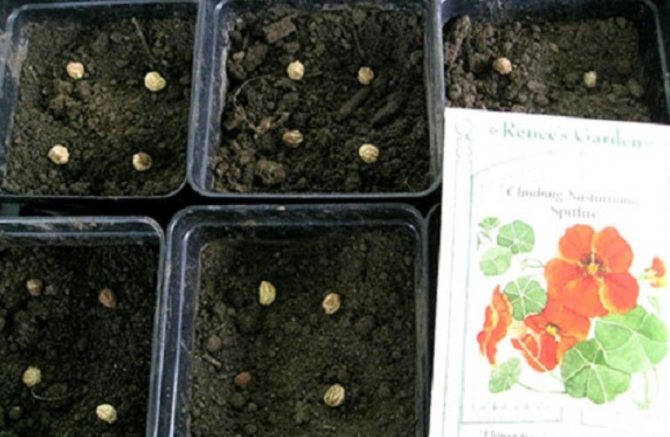

Seedling care
The room where the seedlings are located should be 20-22 degrees. Then the sprouts will appear in 13-15 days. After 2 weeks of cultivation, the temperature is lowered by 2 degrees.
In poor lighting, the seedlings will begin to stretch, so in the future they will be weak. It is necessary to additionally illuminate the plants with phytolamps so that the seedlings receive daylight for 15 hours.
Watering is carried out as the soil dries up. Nasturtium loves dry air, so it doesn't need to be sprayed.
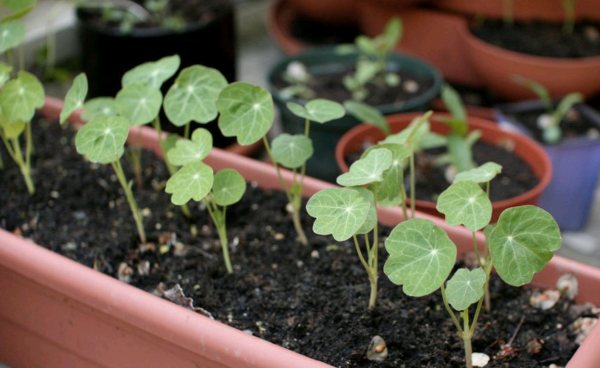

Important! Moisture should not get on the plants. If possible, it is better to pour water into a sump.
The strongest plants are left in the container with seedlings, and the rest are removed.
Landing in open ground
The place for nasturtium is chosen protected from drafts and well-lit. The soil should be fertile, water and air permeable with low acidity. If the soil is not nutritious, then the flowering will be weak and not lush.
Advice! If there is a lot of organic matter in the soil, there will be a lot of greenery, but there will be no flowers. Nasturtium loves mineral fertilizers.
Depending on the climate, transplanting into open ground is carried out from early May to early June on a sunny and warm day. By this time, the seedlings should already have grown to 7 cm.
A minimum of 20 cm is left between the plants, and 40 cm for tall and bushy varieties. The holes dig out a little more volume of cups with seedlings.
The plant is transferred into holes with an earthen lump, soil is poured and watered at the root. Planting mulch peat, compost.
Advice! The first time after transplanting, it is better to cover the plants with a film at night.
Watch the video! Nasturtium: growing and care
Agrotechnical requirements for growing
Many experienced gardeners are aware of the capuchin's unpretentiousness to growing conditions. But despite this, if the goal is to obtain lush flowering, then you need to take care of compliance with several simple requirements.
The soil
The best option for growing a representative of nasturtium will be light and moderately fertile soils with a high-quality drainage system. The decision to grow capuchin in an organic-rich area will not achieve the goal of blooming. This is due primarily to the fact that in such a situation, the plant, due to the abundance of organic fertilizers, will form only excellent shoots.
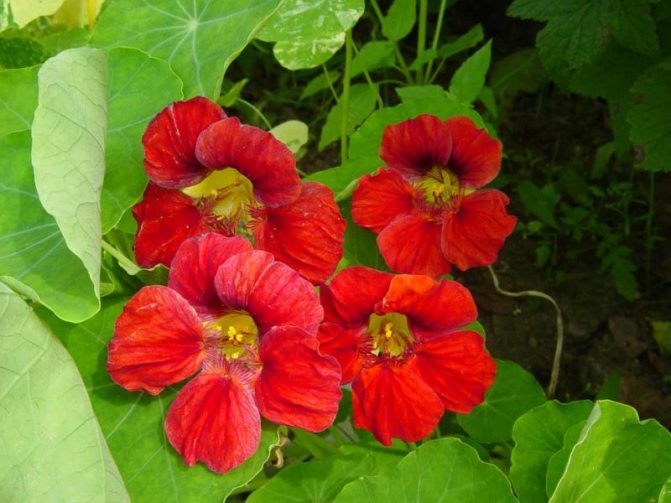

Choosing a location with mostly marginal soils will also not be a good decision. In poor soil conditions, the stems will be bare for almost the entire season, forming only small leaves. And an attempt to grow a culture on heavy soil will not be crowned with success: it will be affected by various diseases, which often leads to its complete death.
Lighting and windiness
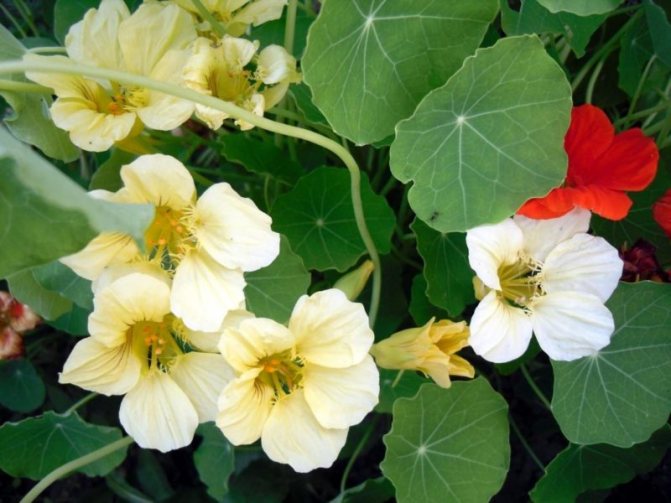

Taking into account that nasturtium is a warm and light-loving culture, optimal conditions for its growth can be created only in areas where access to sunlight is open. Planting a capuchin in a semi-shaded area will yield nothing but strong stems and dense green foliage throughout the season. When choosing a place, it should also be borne in mind that drafts harm it. Therefore, the area where this flower will grow should be windless.
Planting and care when sowing seeds in open ground
In open ground, seeds are sown after the frost has passed, depending on the regions, from April 20 to June 5.
- Before sowing, the seeds are kept in hot water for 15-20 minutes, after which they are soaked for 24 hours in water at room temperature.
- Dig small holes at intervals of 25-30 cm.
- The seed is buried in the ground by 2 cm. 3-4 seeds are placed in one hole.


Important! The air temperature outside should be above 16 degrees.
- In order for the sprouts to appear on the surface of the soil faster, the plantings are watered with water heated to 45-50 degrees.
- The crops are covered with non-woven material to keep warm and accelerate seed germination. Covering material is removed in early June.
- The first shoots can be seen after 15 days.
In this way, plants with good immunity to diseases and climatic conditions can be grown.
Important! Plants will begin to bloom later than when planting seedlings.
Reproduction of nasturtium
The amazing capuchin is known for its decorative and medicinal properties, as well as excellent taste. Thanks to this, he won an honorable place in medicine, cooking, landscape design, and this, in turn, led to the fact that not only experienced florists are engaged in the cultivation of this flower.
Seed propagation


This unique plant propagates using seeds in two ways:
- Seedless method - before sowing, capuchin seeds should be placed in a container with hot water at a temperature of +40 to + 50 ° C for 20 minutes, and then soaked for a day. Growing capuchins using a seedless method has its advantages: growing plants in a permanent place makes it possible to prevent their disease, which often happens with seedlings. However, there is also a minus: the culture blooms later.
- Seedling method - due to the fact that the capuchin has a rather weak root system with a significant leaf surface, it does not tolerate even minor damage to the roots. Therefore, in order to prevent them, seedlings should be grown in separate containers and planted with an earthen lump without picking. The optimal time for sowing seeds in order to obtain seedlings is considered to be April-May.
Propagation by cuttings
Propagation of capuchin is possible by cuttings, which have the ability to root excellently in water and in wet sand. This technique is used, as a rule, when breeding new, and especially terry varieties. Since nasturtium belongs to perennials, for the winter period the most prominent specimens can be left in a container on a well-lit, cool window with watering to a minimum, and in spring they can be stubbed.
Summer care
It is necessary to care for nasturtium during the summer: remove weeds, water and loosen the soil, apply fertilizers.
Watering
Watered with warm water. The first weeks, until the flowers appear, are watered abundantly, after that they are watered only as the soil dries up. Otherwise, the green mass will grow and there will be no flowers.
Top dressing
Moderate fertilization is needed.
Important! From an excess of fertilizer, a green mass will grow, and rare flowers will be lost in it. In order for the flowers to be large and in large quantities, it is not necessary to add organic matter and nitrogen.
Nasturtium is fed once a month. For example, 30 g of nitrophoska or the drug "Agricola-Rose", which are dissolved in 10 liters of water and watered under each bush with 1 liter of solution.
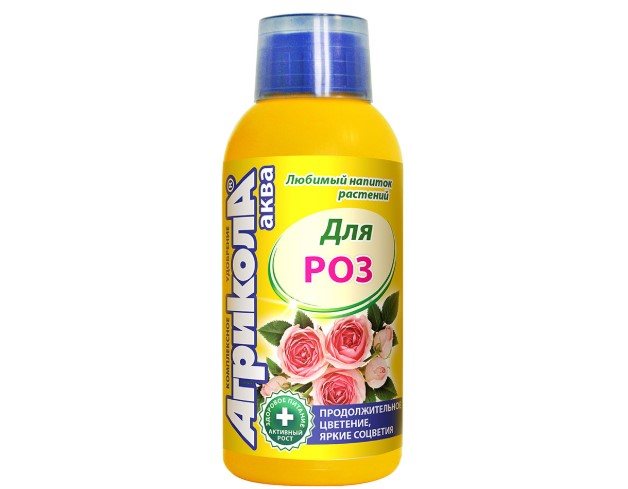

You can stimulate lush bloom by removing wilted flowers. Dead leaves and stems are cut with a sharp knife.
Garden nasturtium care: table
Garden nasturtium cannot be called a capricious flower, but it still requires attention.
| Care steps | Features of the |
| Seat selection | For planting, you need to choose loamy soils with good drainage. Nasturtium is native to the tropics and therefore requires a lot of sunlight. However, it must be protected from direct sunlight. An area where there is a sliding penumbra from tree branches is ideal. |
| Watering | Young plants need frequent and abundant watering. As soon as the first flowers appear, the soil is moistened only when it dries out strongly. Otherwise, instead of flowers, foliage will actively develop, and sometimes the roots may rot. |
| Top dressing | Usually nasturtiums do not need feeding; it is only required on very poor soils. For enrichment, fertilizers are applied before flowering once a week. Complex formulations based on phosphorus are used, and lime and organic feedings for nasturtiums are not suitable. |
| Solution of problems | The most common problem with nasturtiums is yellowing of the leaves. If it manifests itself at the top of the plant, it may be due to lack of nutrition or excessive soil moisture. If the lower leaves turn yellow, do not worry - this is a normal process. |
| Seed collection | The seeds of nasturtiums are large, ripen about a month after the petals wilt. It is necessary to collect seeds immediately after the fruits turn from green to milk. In this form, they are easily separated from the peduncle. |
| Preparing for winter | Closer to autumn, the plant is watered less and less, then they stop doing it altogether. When the shoots dry up, they need to be removed and the ground dug up. In winter, nasturtium will not survive, so in the spring the seeds are sown again. |
As a rule, nasturtium blooms until the end of August.If you want to extend flowering until November, you need to dig up the plant at the end of the season, transplant it into a flowerpot and put it in the house.
Diseases and pests
Nasturtium is not damaged by such pests as cabbage, aphids, whitefly or Colorado potato beetle. Therefore, the flower is often planted between cabbage or nightshade crops to reduce the number of pests.
Other insects love nasturtium, as it is an excellent honey plant for them.
The plant is most often affected by bactericidal wilting. The leaves at the bottom first weaken, then the whole plant dies.
Rust appears as black or brown streaks and spots on the plant. Due to gray rot, brown spots appear on the leaves.


When damaged by a mosaic, motley and bright stains appear on the flowers. Also on them you can notice the manifestation of the annular and leaf spot virus.
Affected plants are removed from the site and burned. The well is treated with a solution of potassium permanganate (it must be hot). Healthy flowers are treated with insecticides such as Topaz, Ridomil, Oksikhom.
Plant use
Nasturtium in landscape design is used for vertical and horizontal gardening. It forms a continuous green cover on the soil or trellis. Plants with brightly fragrant flowers look good in mixborders, flower garden foregrounds, and arbor walls. They are spectacular in combination with bells, delphinium, ageratum.
Flowers and foliage of nasturtium are used in cooking for the preparation and decoration of salads, sandwiches, soups. The leaves are similar in taste to watercress leaves. They have a bitter, refreshing taste. Dried flowers have an intense aroma and are used in a tea bouquet. The fruits of the plant are pickled, they taste like capers.
The healing properties of nasturtium are very great. It is a herbal antibiotic and contains a rich vitamin complex. They use decoctions and alcoholic tinctures, which are drunk to strengthen the genitourinary system, fight colds and sore throats, and treat scurvy. Rinse hair with broths to strengthen them and wipe problem skin.
Contraindications to nasturtium are reduced to limiting the intake of people prone to allergies. Also, excessive use irritates the gastrointestinal tract and mucous membranes.
Loves, does not love - the secrets of agricultural technology
Knowledge is behind the unpretentiousness of the flower and the simplicity of its agricultural technology, as always. About its origin, biological characteristics, vegetation cycle. Nasturtium also has secrets.
Sun flower
She is light and heat-loving, like a real native of the tropics. If you plant nasturtium in partial shade, it will “wrap up” in leaves and bloom much worse. To reach her full potential, she needs the sun. A lot of sun.
Watering it also needs "tropical" - infrequent, but plentiful, so that the soil gets wet to the last root. During flowering with watering, it is generally better not to rush, wait for the soil to dry out, and then give a moisture-charging dose.
The heat-loving nature of the flower is also manifested in the fear of the slightest frost. Never rush to sowing, let alone planting seedlings, wait for steady spring heat.
More a gourmet than a glutton
Installation - the more fertile the soil, the better, it does not work for nasturtium, and this must be the fate of planting and caring for the plant.
On greasy soil, rich in humus, it drives foliage and blooms worse. It is also not necessary to keep it from hand to mouth, but it is better to feed it less often with targeted "goodies" - mineral complex fertilizers for flowers. It is better to refuse manure, mullein, humus and other organic matter altogether.
Variety selection
Luxurious flower beds made of nasturtium on the streets of the cities of Peru captivated the hearts of the Spaniards so much that several species of plants were exported to Europe.To date, breeders offer the attention of landscape designers many varieties and varieties, including:
- Black lady - with elegant maroon rims, decorated with a yellow center;
- ladybug - with scarlet specks at the base of each vanilla-colored petal;
- Day and night - contrasting mixture with lemon yellow and burgundy flowers;
- Silk road - terry variety with an impressive palette of shades;
- Maiden beauty - a mixture of yellow, orange and purple flowers;
- King Theodore - with bloody scarlet flowers without marks;
- Cherry rose - dark pink terry beauty.
The variety of habitus allows capuchins to be grown in different parts of the garden and even in the apartment. Low-growing nasturtium on the balcony in a small container is a good decoration for the facade of the building. In hanging pots, ampelous varieties (Yeti, Salmon) look decorative. Climbing nasturtium of the Alaska variety with a marble pattern on the leaves looks amazing in gray street flowerpots "antique".
Curly nasturtium with long, up to 3 m, shoots is used to decorate fences and outbuildings. Foreign nasturtium quickly tightens metal nets with a large mesh, forming even rich green columns with a scattering of yellow flowers. Shrub variations of the plant complement with their bright flowers floristic ensembles in a flower bed, a rabatka, a mixborder.
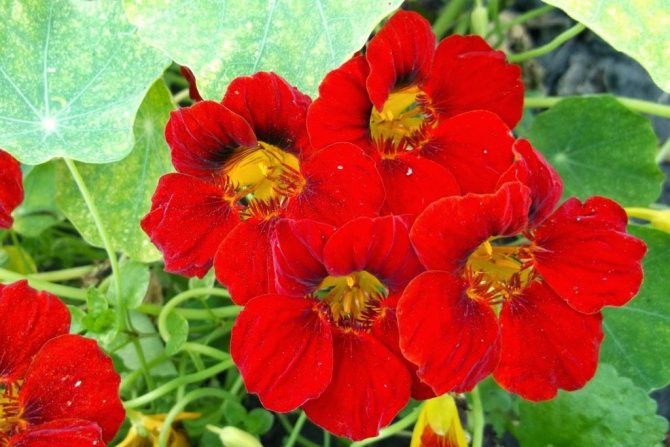

Cherry Rose is a deep pink terry beauty.
Water and feed in moderation
| Watering and loosening
|
| Fertilizers and feeding
|
| How to collect seeds
|
Modest and effective: description and pedigree of a tropical flower
Nasturtium is another "tropical bird" that came to our latitudes during the Great Geographical Discoveries. Her homeland is the jungle of the New World (Mexico, Peru, Ecuador).
The herbaceous plant of the Nasturtium family is classified as a perennial, but in our harsh climate it can only grow in an annual crop. The genus includes over 50 species. Cultivated as natural species introduced into cultivation are large nasturtium, foreign, shield-bearing, but the most widespread N. cultural, representing a large family of varieties and hybrid forms of the plant.
With a relatively small root system, the annual forms a massive amount of greenery. Its stems are thick, juicy, actively branching, capable of growing lashes 1.5–2 m long.
Nasturtium has very beautiful leaves - large, thyroid, on long petioles, which gives the plantings an additional decorative effect and, with proper care, provides a rich green color before frost.
But, of course, flowers make an annual bright and spectacular. Someone in the form of a corolla sees a hood, someone - a helmet - on long pedicels they rise above the leaves and blaze with red-orange petals. Each flower is single, 5–6.5 cm in diameter, unusually graceful, with a delicate aroma.In mass, they create a lush blooming cap that contrasts beautifully with the green background of the foliage.
The seeds of nasturtium are large, irregular in shape, collected in 3 pieces per fruit. From above, they are covered with a wrinkled peel, which is recommended to be soaked in warm water before planting and removed. This will speed up germination.
Content
- Listen to the article
- Description
- Growing nasturtium from seeds Sowing
- Seedling care
- When to plant
- How to care
- Foreign nasturtium (Tropaeolum peregrinutn)
How to collect seeds
You can collect seeds yourself from those flowers that grow on the site. They ripen when the plant withers. Only Kenar nasturtium does not have time to ripen before frost. At first the seeds are green, then they turn whitish. They are easy to separate from the peduncle. So that they do not fall asleep on the ground, they need to be collected in time. Allow the seeds to dry out for a while in a warm room. Then send it to storage in cardboard boxes.
Nasturtium is one of the most common and popular flowers in flower beds and backyards. Even an inexperienced florist can grow it. The plant is unpretentious in care, does not require a lot of time and effort. Knowing the features and timing of sowing nasturtium, you can achieve abundant flowering from June to the onset of frost.
More useful information about the nuances of caring for nasturtium can be found after watching the video:
Seed collection
Capuchins are among those rare crops from which you can collect seeds without buying them annually. In addition, they are well stored for several years and will not lose their germination.
To obtain seeds, one lash is left, from which dried flowers are not removed, where the seeds are formed. They are large and green in color. When ripe, they become whitish. The seeds ripen 40-50 days after the flower withers.
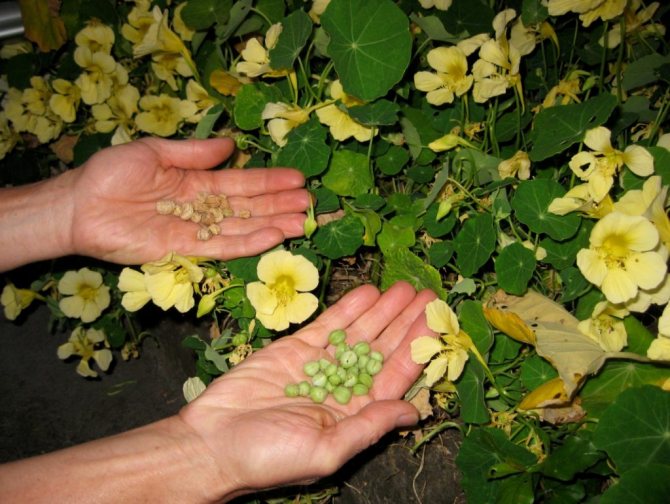

Nasturtium seeds can be harvested on their own and planted in subsequent years
The seeds are harvested without waiting for them to scatter on the soil (self-seeding will occur). Dosing takes place in a warm, ventilated room. After the seed has dried, it is placed in paper bags and stored until next spring at room temperature.
With thoughtful, correct placement, nasturtium will give the site a bright and elegant look throughout the summer, without requiring much hassle from you to care for. She is unpretentious and copes with many difficulties on her own, and the florist's task is only to help her a little in this.
back to menu ↑
See also: Dahlias: a description of the 10 most beautiful varieties, planting and care (100 Photos & Videos) + Reviews
Medicinal properties and harm
The richness of the vitamin composition of capuchin determines its medicinal properties:
- bactericidal - for the treatment of various kinds of inflammatory conditions;
- antiscorbutic - to combat vitamin deficiencies;
- expectorant - to relieve cough;
- diuretics - to eliminate puffiness.
The beneficial properties and contraindications of nasturtium are associated with the individual reaction of the body. To check it, you must first try to chew one leaf and make sure that there is no allergy. You can not use nasturtium for people with acute stages of inflammation of the stomach and intestines. The plant is not recommended for children, pregnant and lactating women.
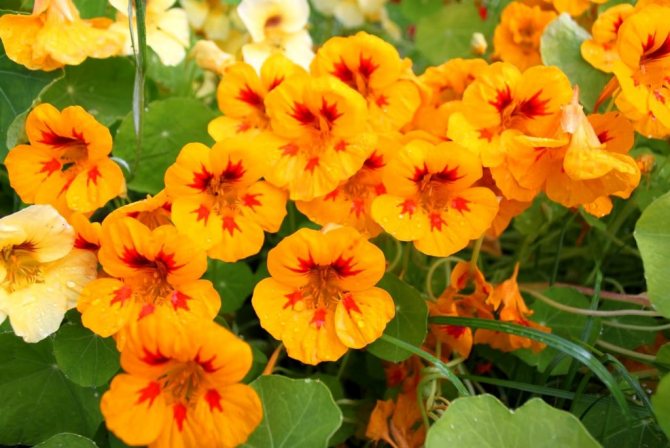

Nasturtium medicinal properties
Cooking applications
Nasturtium is not just an ornamental plant. Its flowers, leaves and seeds are edible and often used in various salads (they have a slightly pungent aftertaste).
The plant is also used as appetizers for meat and other main dishes. Both the young leaves and the nasturtium flower have an interesting, unconventional taste, very delicate. Flowers are eaten raw or baked. Nasturtium fruits - small seed baskets - can be pickled in vinegar, their taste and appearance are close to capers.
Due to the intense aroma and slightly pungent taste, the seeds are used instead of horseradish in the preparation of tartar sauce, if you mix the crushed leaves and add nuts or almonds - you get a hot pesto sauce.
"Capers" from nasturtium
Ingredients:
- fruits of nasturtium;
- spices (cloves, allspice, black pepper).
For the marinade:
- ½ glass of wine vinegar (0.1 L);
- 2 glasses of water (0.5 l);
- ½ cup of sugar (100 g);
- 2 teaspoons of salt.
Preparation
- Green fruits of nasturtium are immersed in boiling water with a spoonful of salt, boiled for 5 minutes, the water is drained.
- Transfer the fruits to small jars.
- Prepare the marinade: pour water, vinegar into a large saucepan, add sugar, salt. We put on fire, stirring with a spoon. When the sugar dissolves, the marinade will boil, remove from heat and pour into jars.
- The jars are twisted and pasteurized in a saucepan filled with water up to 2/3 of the height for 15 minutes.
Ripe fruits (only green) are harvested in August and September.
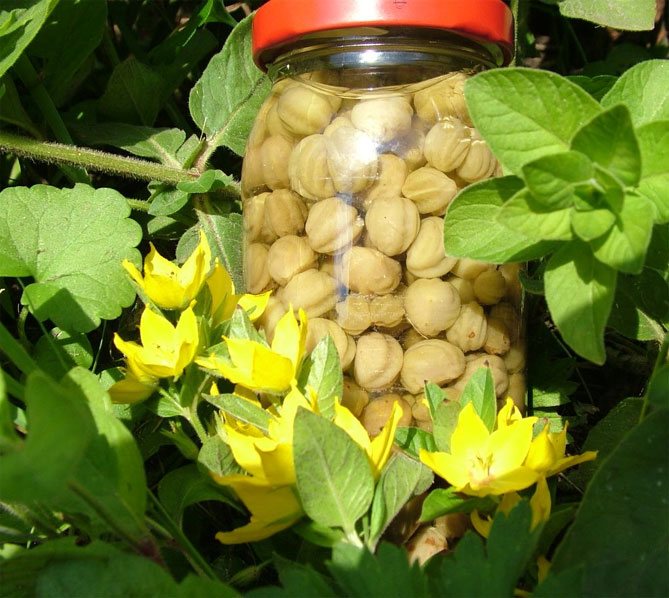

How to choose the right soil for planting nasturtium
The soil suitable for growing nasturtium seedlings, as well as for the permanent residence of an adult plant, should be:
- slightly acidic;
- highly nutritious;
- well drained.
An excess of organic fertilizers in the soil can lead to the fact that nasturtium will very actively increase the green mass, and will not bloom at all.
Depleted soil will cause the leaves of the plant to not grow large enough, making the stems look bare and the buds small.


Constantly moist soil in the lowlands, containing excess moisture, can lead to rotting of plants
It is also not required to fertilize the soil with purchased mixtures excessively, since nasturtium is unpretentious. Monitor the condition of the ground as closely as possible and you will get a healthy planting.
Where to plant
Loose soil of average fertility is required for nasturtium. The composition of the soil is slightly acidic. On ship and heavy soils, the flower loses its decorative effect, the stems become bare and wither. Before planting, a complex fertilizer rich in phosphorus is applied to the ground. Excess nitrogen leads to overgrowth of leaves and delayed flowering.
The place is allocated sunny, without drafts. It is not recommended to keep nasturtium under the scorching sun. For potted culture, a balcony or veranda on the east and west side is suitable. In the shade, with a lack of light, the plants will be weak and give small flowers.
Plant requirements for soil, climate
Most of the cultivated species come from warm climates and have similar cultivation requirements.
The best position for nasturtium is a sunny, warm place, sheltered from the wind.
The soil should be:
- easy;
- moderately fertile (for large nasturtium it can be rather weak);
- slightly damp.
Plants do not tolerate low temperatures, swampy soils, in such conditions they often get sick, inhibit development.
Attention! For nasturtium to bloom profusely, it must grow in relatively poor soil, fertile soil will cause vigorous growth of leaves by reducing flowering.
Regular garden soil works best. The plant needs a permeable substrate, so one should not forget about the expanded clay layer in the pots.
Nasturtiums planted in the shade almost stop blooming or bloom poorly, so the abundance of sun is an important criterion for choosing the right position in the garden. With less sunlight, the plant quickly spreads over the site, but blooms little.
It is worth immediately planting nasturtium in a permanent place, it does not tolerate damage to the root system and is unlikely to take root in a new place after transplantation.
Florist reviews
Passific
In the shade, it is able to grow, only the flowers will be small, and the leaves will be large. As a result, you can get not a blooming nasturtium border, but a green mass
Lena I
It grows well in my dacha, tk. the ground is rather heavy loam. And oddly enough, she really likes it. I sow directly into the ground in early May. Only when landing in the holes I put a few minutes. fertilizers.
Let's summarize
Nasturtium is not only a beautiful plant, but also useful. Try to grow it in the garden, and you will enjoy flowering all the warm days. In addition, you can harvest nasturtium as a natural medicine, as it has anti-inflammatory, antioxidant, diuretic, and other equally valuable effects. The final result will depend on how carefully you monitor the plantings during the growing season, but do not be afraid, you will not have to overexert, because nasturtium is unpretentious in everything.
In folk medicine
Nasturtium is to some extent a medicinal plant - its ripe seeds have bactericidal properties. In medicine and herbal medicine, seeds, leaves, flowers and fruits are used.
Flowers can be picked and dried in August-September. Fresh plants are also used to make tinctures.
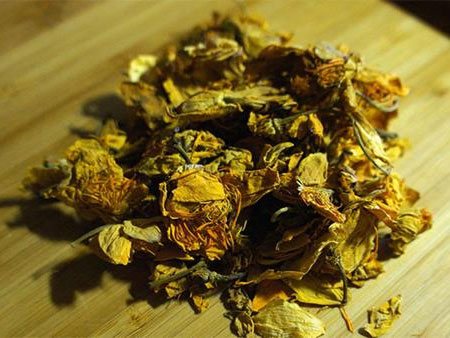

Large nasturtium is rich in vitamins B, C, mustard glycoside, contains organic sulfur compounds (they greatly affect the smell and taste of the plant), potassium salts.
Extracts are made from the fruits that have healing properties:
- improving digestion;
- having a choleretic effect;
- diuretics;
- dried buds of nasturtium are an excellent laxative;
- acts as a natural antibiotic, especially against bacteria that cause urinary tract infections;
- have strong antiparasitic properties;
- act sweatshops;
- antipyretic;
- has antiseptic properties, successfully treats some skin diseases;
- perfectly removes dandruff - has a fungicidal and yeast effect, stimulates hair growth;
- heals minor cuts and scrapes;
- tea from nasturtium is sometimes used for colds, it warms, is useful for inflammation of the bronchi, throat, tonsils and various colds.
Nasturtium should not be abused by people with peptic ulcer disease, kidney disease.
Beneficial features
Nasturtium is often used not only as an ornamental plant, but also as food, it has many useful properties. Almost all parts of nasturtium are edible except for the roots. Fresh shoots and young leaves can be added to salads, minced meat, soups and drinks. They give a spicy taste and, in addition, contain a large amount of vitamin C. Ground seeds may well serve as a substitute for spicy seasonings for various dietary dishes. Nasturtium seeds produce an excellent edible oil that tastes like mustard oil.
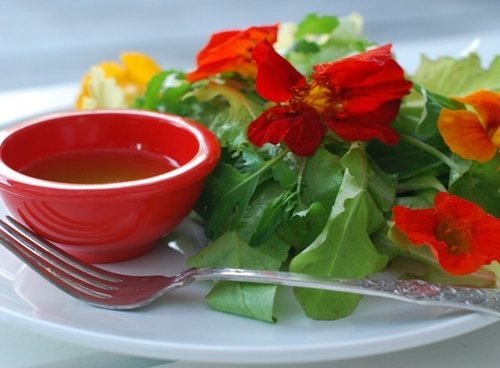

In the stems, leaves and flowers of nasturtium, a large number of different elements with healing properties have been identified. These are: ascorbic acid, carotene, tocopherol, phylloquinone, as well as iron and iodine. The juice contains various acids: stearic, oleic, palmitic, linolenic.
In folk medicine, it is successfully used to treat a number of diseases such as scurvy, atherosclerosis, angina pectoris, metabolic disorders. It is considered an effective treatment for vitamin deficiency, anemia and skin diseases. Nasturtium juice is used for burns. A decoction for the treatment of liver diseases, with gout, anemia, rheumatism and diabetes mellitus. Nasturtium tincture is used as a hair growth stimulant.
In pharmaceuticals, the substance tropolein is used, extracted from essential oils of nasturtium, which are used in the manufacture of drugs for the treatment of chronic coronary insufficiency.
In cosmetology, nasturtium has recently been used very widely. it is included in the compositions of various ointments, creams, balms for various types of skin and hair.
We hope that after reading our review, you will appreciate this truly unique plant and soon these cute and useful plants will appear on your site that will decorate your summer cottage and, if necessary, can benefit your family.



